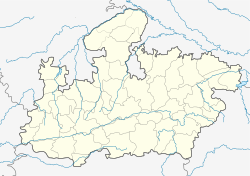Patalkot, India
| Patalkot | |
|---|---|
| Town | |
| Location in Madhya Pradesh, India | |
| Coordinates: 22°15′N 78°28′E / 22.25°N 78.46°ECoordinates: 22°15′N 78°28′E / 22.25°N 78.46°E | |
| Country |
|
| State | Madhya Pradesh |
| District | Chhindwara |
| Tehsil | Tamia tehsil |
| Languages | |
| • Official | Hindi |
| Time zone | IST (UTC+5:30) |
| ISO 3166 code | IN-MP |
| Vehicle registration | MP |
| Website | www |
Patalkot (Sanskrit for "very deep") is a valley in the Tamia tehsil of Chhindwara district in Madhya Pradesh, India.
The Patalkot valley is spread over an area of 79 km2. at an average height of 2750–3250 feet above Mean Sea Level from 22.24 to 22.29 ° North and 78.43 to 78.50 ° East. The valley is located at a distance of 78 km from Chhindwara in the North-West direction and 20 km from Tamia in the North-East Direction. 'Doodhi' river flows in the valley. This horse–shoe shaped valley is surrounded by hills and there are several pathways to reach the villages located inside the valley.The rocks are mostly by the Archaean era which are nearly 2500 million years and comprised with Granite gneiss, green schists,basic rocks, quartz with Gondwana sediments including conglomerate sandstone, shales and carbonaceous shales. The composite carbon on the rocks called Shilajit is also found on few patches in upper zones.
'Patalkot' name comes from Sanskrit word "Patal" that means very deep. There is a belief that after worshipping 'Lord Shiva', Prince Meghnath son of Ravana had gone to Patal-lok through this place only. People say that Bhonsle Kings ruled this place in the 18th and 19th Centuries and that there was a long tunnel connecting this place to Pachmarhi in Hoshangabad District. The Bhonsle King after defeated from British Army found this place suitable for hiding and went deep into the forest of Patalkot. The area is called RajaKho in Patalkot. Traditionally, the site is believed to be the entrance to Patal. This valley had long been cut off from the outside and was discovered only a few years back. Patalkot has been a home to a tribal culture and custom since its origin.
In recent years, the government has been trying to make Patalkot an eco-tourism destination. The monsoon season is a popular time for visitors, as it is a sheltered area. Tourism marketing focuses on the local nature and adivasi culture connections - though this may change with increased impact from tourism and outside pressures. Patalkot is known for retaining its original culture and customs for a long time. Until a few years back, it was a world in its own with no influence from outside. To reverse the process of deforestation and forest degradation by positioning in ecotourism as a joint product. The Patalkot model of ecotourism, with the involvement of indigenous communities, has demonstrated its operational deliverance, adaptive evolution capabilities as well as been recognized as a successful model with several elements for replication. It started in 2009 with the joint effort of the 'Centre for Forestry Research' and HRD Poama, District Administration and District Olympic Association in which 3000 tribal youth were trained in adventure activities like parasailing, paragliding, rock climbing, trekking, bird watching and water sports. Every year a festival called Satpuda Adventure sports festival is organised during the month of October.
...
Wikipedia


